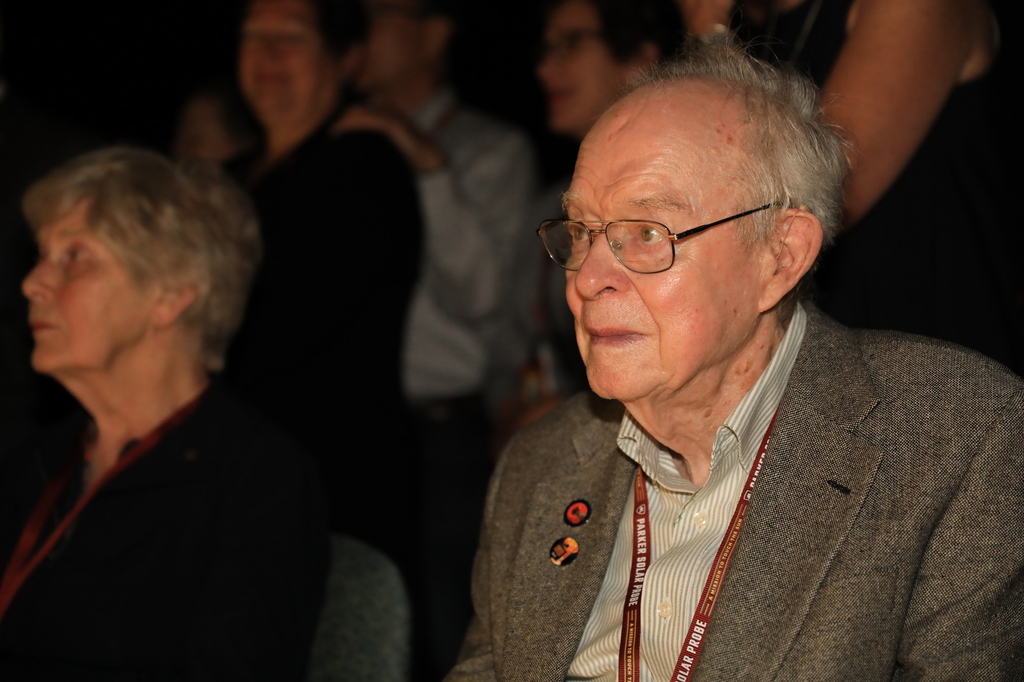Parker Solar Probe Gets Visit From Namesake
B-roll
Eugene N. Parker, professor emeritus at the University of Chicago, today visited the spacecraft that bears his name: NASA’s Parker Solar Probe. This is the first NASA mission that has been named for a living researcher, and is humanity’s first mission to the Sun.
Parker proposed the existence of the constant outflow of solar material from the sun, which is now called the solar wind, and theorized other fundamental stellar science processes. On Oct. 3, 2017, he viewed the spacecraft in a clean room at the Johns Hopkins Applied Physics Laboratory in Laurel, Maryland, where the probe was designed and is being built. He discussed the revolutionary heat shield and instruments with the Parker Solar Probe team and learned how the spacecraft will answer some of the crucial questions Parker identified about how stars work.
NASA’s Parker Solar Probe is scheduled for launch on July 31, 2018, from Cape Canaveral Air Force Station, Florida. The spacecraft will explore the Sun’s outer atmosphere and make critical observations that will answer decades-old questions about the physics of stars. The resulting data will also improve forecasts of major eruptions on the sun and subsequent space weather events that impact life on Earth, as well as satellites and astronauts in space.
Credit: NASA/Johns Hopkins APL/Lee Hobson

Still image
Eugene Parker, professor emeritus at the University of Chicago, visiting the spacecraft that bears his name, NASA’s Parker Solar Probe, on Oct. 3, 2017. Engineers in the clean room at the Johns Hopkins Applied Physics Laboratory in Laurel, Maryland, where the probe was designed and is being built point out the instruments that will collect data as the mission travels directly through the Sun’s atmosphere.
Credits: NASA/JHUAPL

Still image
Eugene Parker (center), professor emeritus at the University of Chicago, visits the spacecraft that bears his name: NASA’s Parker Solar Probe. Thomas Zurbuchen (bottom right), the associate administrator for NASA’s Science Mission Directorate, and Ralph Semmel (behind Parker), the director for the Johns Hopkins Applied Physics Laboratory in Laurel, Maryland, where the probe was designed and is being built, joined the tour.
Credits: NASA/JHUAPL

Still image
Nicola Fox (bottom left), project scientist for NASA’s Parker Solar Probe at the Johns Hopkins Applied Physics Laboratory in Laurel, Maryland, describes the mission to the scientist for whom it’s named: Eugene Parker (middle). Eugene Parker first proposed the existence of the constant outflow of solar material from the sun — now called the solar wind — through which the spacecraft will travel. The red frame on the end of the spacecraft is a stand-in for the mission’s thermal protection system, which will reach temperatures of 2,500 degrees F during its journey.
Credits: NASA/JHUAPL

Still image
Eugene Parker, professor emeritus at the University of Chicago, visits the spacecraft that bears his name, NASA’s Parker Solar Probe, at the Johns Hopkins Applied Physics Laboratory in Laurel, Maryland, where the probe was designed and is being built. The spacecraft is humanity’s first mission to a star — it will travel directly through the Sun’s atmosphere.
Credits: NASA/JHUAPL
Credits
Please give credit for this item to:
NASA/Johns Hopkins APL
-
Producer
- Joy Ng (KBR Wyle Services, LLC)
-
Videographer
- Lee Hobson (Johns Hopkins University/APL)
-
Photographer
- Ed Whitman (Johns Hopkins University/APL)
Release date
This page was originally published on Thursday, May 17, 2018.
This page was last updated on Wednesday, May 3, 2023 at 1:46 PM EDT.

![PRODUCED VIDEOMusic credit: “Closer to You” by Sam Cleeve [PRS] by Universal Production Music.Watch this video on the NASA Goddard YouTube channel.Complete transcript available.Additional footage credits: 00:00-00:12 (University of Chicago)00:24-00:28 (University of Chicago)00:29-00:40 (Photo credit: Emilio Segrè)01:32-01:36 (University of Chicago)01:41-01:50 (University of Chicago)01:57-02:04 (University of Chicago)02:05-02:10 (Photo credit: University of Chicago)](/vis/a010000/a014100/a014120/14120_EugeneParker_YouTube.00065_print.jpg)